In the first half of our Top Ten Most Versatile EDH Cards of 2021, we addressed some honorable mentions of the set that worthy of attention, as well as counted down cards 10-6. Today, we’re looking at the remaining five cards and how they stack up to one another.
We all know why we’re here today, so let’s get right to it!
Number Five: Sparkhunter Masticore
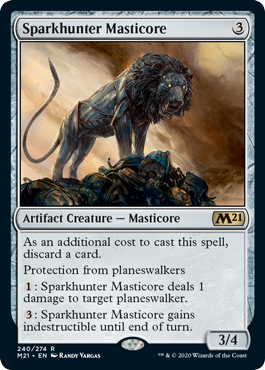 First off, can we all agree that having masticore-based creatures always force you to discard a card as part of its identity is just a little strange? I get that it was a key part of the original Masticore, and so when they made the throwback homage years later with Razormane Masticore it made sense. Now it’s just…a thing. For the sake of being a thing.
First off, can we all agree that having masticore-based creatures always force you to discard a card as part of its identity is just a little strange? I get that it was a key part of the original Masticore, and so when they made the throwback homage years later with Razormane Masticore it made sense. Now it’s just…a thing. For the sake of being a thing.
When you get past that hangup, what stands before you is easily one of the most deceptively useful cards to come out of Core Set 2021. That is, at least from a Commander perspective.
First off, Sparkhunter is a 3/4 colorless creature for three mana, which isn’t all that bad given that the raw power ratio of cost to size with artifact creatures generally isn’t super favorable. This is offset, however, due to that fact that it also requires you to discard an additional card when casting it. So be it.
Second, Sparkhunter has a recurring means of protecting itself for a modest mana cost. With its final ability, the Sparkhunter says that for 3 mana it gains Indestructible for the turn, ensuring in most cases it can survive an unfavorable combat, a board wipe, or many targeted removal cards. While most players understandably prefer their creatures to simply have it as a static ability and generally shy away from using temporary invulnerability due to expensive activation costs, this creature’s means of self-preservation is much more palatable. Most EDH players are going to have at least a few mana sitting around more often than not, and periodically paying 3 mana to keep this apex hunter around is so worth the investment.
Of course, it’s biggest selling point lay with its namesake: this thing obliterates planeswalkers. For a single mana activation, Sparkhunter Masticore can deal one damage to any planeswalker on the battlefield at any time, effectively giving you the means to removal loyalty at will at a 1:1 ratio. Suddenly a loose 4-5 mana is a death sentence to a most planeswalkers, letting you bypass their battlefield-based defenses to peck them to death from afar. Then to top it all off, the Sparkhunter also has Protection from planeswalkers, thereby nullifying their ability to retaliate directly using their own abilities.
All told, Sparkhunter Masticore is a planeswalker eating machine that can shoot from across the battlefield while mostly being able to protect itself from being casually picked off – so long as you have some mana to spare. And thanks to its Artifact nature it can be slotted into any Commander deck.
Of all the cards in our Top Ten list, Sparkhunter Masticore may be the most underrated of the lot. And it really shouldn’t be.
Number Four: Double Vision
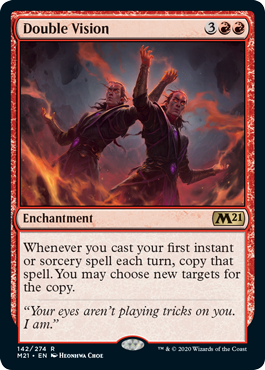 Of all the cards on this M21 list, none of them require fewer explanation as to their scalability and general usefulness in a Commander game than Double Vision. This is the kind of card that is absolutely tailor made for the format. It’s a straightforward Enchantment that asks one simple question of its owner: “Would you like free spells?”
Of all the cards on this M21 list, none of them require fewer explanation as to their scalability and general usefulness in a Commander game than Double Vision. This is the kind of card that is absolutely tailor made for the format. It’s a straightforward Enchantment that asks one simple question of its owner: “Would you like free spells?”
We’ve never met a Magic player yet who has said no to that question.
For five mana, Double Vision provides exactly that purpose. Its effect is such that the first Instant or Sorcery spell you cast each turn brings with it a free Reverberate kicker. In Commander games this could be something as innocuous as a utility spell, card draw, or mana acceleration. Or it could be an expensive, explosive card that significantly upends the current board state – something EDH sees plenty of.
After all, what’s better than one instance of Death by Dragons, Kindred Charge, or Mana Geyser? Two instances!
The one thing that may get overlooked, however, is that Double Vision’s free copy spell isn’t just limited to your turn – it gives you the free copy the first time you cast a spell during any turn – which can be especially fruitful with reactionary cards or with minor spells that are more efficiently cast on the turns preceding your own.
Kaboom! indeed.
Number Three: Fiery Emancipation
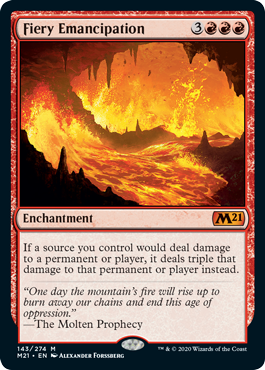
Yeah…Core Set 2021 was pretty generous to Red mages this time around. None of them perhaps most so than with the splashy and dangerous Fiery Emancipation – arguably one of the most explosive additions to the color’s damage output potential in some time.
For many, many years, if you were to ask what this color’s pinnacle option was for boosting damage output, the answer almost always was Furnace of Rath: a blistering four mana Enchantment that, quite literally, doubled all damage dealt in the game, regardless of source or player. The idea of course was that you wanted to blitz your opponent by taking advantage of the Furnace’s damage doubling with a flurry of spells and attacks before your opponent could do the same. Often this worked, particularly in burn decks. Sometimes it didn’t. But it almost always expedited a game. When a Furnace of Rath hit the board, everyone took notice.
Fiery Emancipation hears that and wants you to hold its molten beer.
Costing two additional mana more than Furnace of Rath (and one more than the later near-reprint Dictate of the Twin Gods, Fiery Emancipation is not a cheap Enchantment to cast. However, to say the added cost is worth the upgrade in efficacy is a severe understatement.
For one, Fiery Emancipation increases your damage output potential by a staggering 100% over its predecessor, letting you triple the damage of anything you dish out. A paltry Lightning Bolt (by Commander standards anyhow) now deals 9! damage for one mana. Incite Rebellion says each player will take 3 damage for each creature they control, which could be down right deadly on a packed board. Your basic 5/5 dragon will start clocking for 15 damage every time it’s in combat. The sheer amount of damage-dealing Fiery Emancipation can fuel is immense, making it an incredibly versatile card…even if it isn’t all that creative conceptually.
At the same time, Fiery Emancipation removes the one drawback that its previous brethren possessed: only you now benefit from its effect. Whereas with the Furnace everyone was handed a box of grenades to play with, with this Enchantment the entire arsenal is yours alone.
On the one hand, this ensures that your own card can’t be used against you, which is reassuring in a Commander game given the aforementioned mana investment. On the other hand, the card brings with it a giant neon sign that says THREAT. Fiery Emancipation significantly amps up any Red deck with minimal effort, making even a modest board state an area of concern. As a result, it will likely be a desired target for removal – so use it as opportunistically as possible while you can.
Number Two: Card Draw!
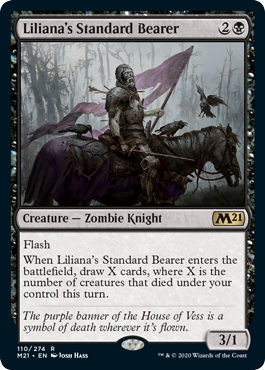
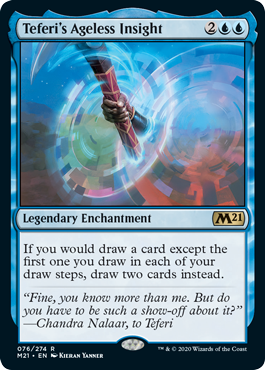
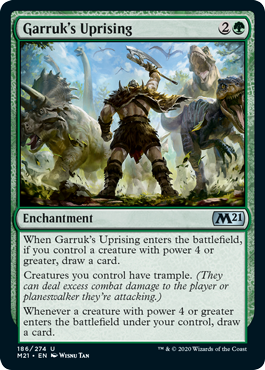
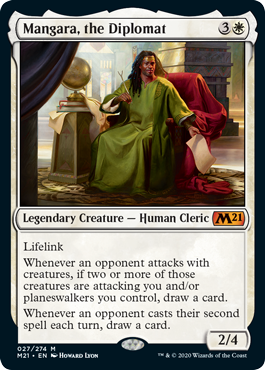
It’s been stated ad nauseum that multiplayer games, and Commander games in particular, reorient what the most important traits to a deck are. Unlike normal duels, for instance, speed is not paramount. It’s not even in the upper tier of importance. Games of EDH don’t end by Turn 4. They aren’t over in 15 minutes. Speed can be helpful for setting oneself up with decent board position early, but it’s not an absolute necessity. In fact, if you come out swinging too hard, all you’ll likely do is rally the table against you.
Instead, multiplayer games revolve mostly around two aspects: the ability for the game to move forward, and the depth of your deck’s capabilities. The first manifests in different ways, but it ultimately means that for multiplayer games to progress, one’s deck needs to be able to keep moving a game forward. When a game stalemates out too long it can drag down the fun of the game. This means being able to build up enough mana to cast the spells in your deck even after the possibility of a complete board wipe. It means having answers to all-too-common logjams at the table with removal cards or spells to punch through your opponent’s defenses. It means being able to be proactive and not completely rely on the goodwill of other players to fix every threat on the board for you. Unlike dueling, Commander decks reward those who build with flexibility and variability in mind rather than than a having a super streamlined deck that focuses mostly on what it needs to do to win. There, speed usually trumps versatility. Here, the opposite is true.
The second aspect is the depth of your roster. One of the reasons that Red burn decks almost always fare poorly in multiplayer is that they blaze through all of their ammo quickly. Sure, it may even be enough to take one player out, but then they have to face several other opponents and are sitting with an empty hand, limping along until they are either swatted down themselves or luck into another powerful spell.
Therefore, the biggest key to any multiplayer deck is the means to draw additional cards. Cards mean options. Options mean being able to adapt to an ever-changing situation. A perennial empty hand in EDH is tantamount to a death sentence because it a) signals to your opponents you have no response to the moves they make, and b) means you have no response to the moves they make. It’s also less fun. Which is where this crop of M21 cards really comes in handy.
Is putting four of them together for one slot a bit of a cheat? Perhaps. But they all share the same purpose, depending on your color of choice…mostly. (Sorry Red.)
You don’t need to draw your entire deck for card draw to be effective. Indeed, as these cards illustrate, any ability to draw additional cards is incredibly useful for keeping up with (or even gaining an upper hand on), what’s transpiring in the game. Though each of these cards tackles how it provides that benefit in different color pie friendly ways, the overarching premise is the same. And the general nature of how they provide that card draw ensures that they can be added to a wide cross-section of decks with minimal effort.
Garruk’s Uprising and Teferi’s Ageless Insight are an affable pair of Enchantments that exemplify this fact, costing three and four mana, respectively. In Teferi’s case, it rewards you with a doubling effect on any card you draw beyond the forced draw of the turn – which in Blue decks is very easy to take advantage of (or even abuse). Garruk’s Uprising by contrast takes the typical Green approach of tying draw draw to creatures, in this case whenever you drop out a creature of power 4 or greater – plus a bonus if you already had one out when the Enchantment hits the battlefield. It’s almost – almost – an afterthought here, but it also gives your army Trample as well. Which is pretty useful all by itself.
On the other side are two creatures with slightly different tact. In the case of Liliana’s Standard Bearer, you have a 3/1 for three mana you can Flash onto the battlefield that lets you draw a card for each of your creatures that died this turn. Unlike the other cards mentioned it is a one-time effect, and it is conditional on being on the losing end of a major combat or board wipe, but it’s also card draw in Black that doesn’t cost any life in order to obtain them. That alone is an uncommon trait. Plus, if you lose even a handful of creatures it has the means of replenishing your hand incredibly quickly. Oh, and it can also be used as a surprise blocker.
Finally, there is the classic legendary character Mangara, which enters as a 2/4 Lifelink for four mana – in and of itself not terrible. Yet Mangara’s real merit resides with his pair of passive card draw triggers. The first says that if an opponent attacks you with more than one creature, you get to draw a card. The second says that if an opponent casts a second spell on any given turn, you draw off that too. Although you have little control over when Mangara will trigger than the others mentioned here, both of these triggering criteria are nevertheless incredibly common in Commander games, all but ensuring a reliable, repeatable card draw effect in White. Which, while slightly less rare than it used to be, is still rare enough to be worthy of mention. Mangara’s legendary status also makes him a viable candidate as a Commander, regardless of whether you would want to build around it for added effect or simply just have a defensive Commander letting you draw cards on the regular. Either way, it’s an added possibility.
Number One: Elder Gargaroth
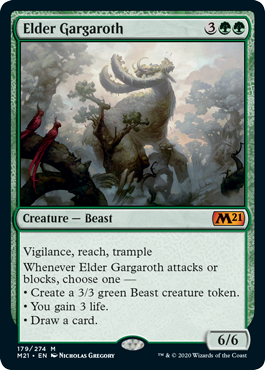
We have to admit: this was not the card we originally envisioned when ranking M21 for widespread Commander potential. And in some ways, we almost wish it hadn’t come to that. However, when it comes to sheer flexibility of use and overall resourcefulness, the longer we thought about it, the more evident it became.
Green has had a tight association with big, stompy creatures for as long as Magic has been around, with many of the scariest creatures in a set almost always either being large fliers or whatever the lumbering behemoth Green was bestowed. Green is the color of nature, and sometimes nature makes terrifyingly giant creatures that want to thrash about. Green mages simply encourage them to do so in your direction.
Over time though, Wizards started pushing more aggressively built and aggressively costed creatures as a means of giving Green a competitive edge on the tournament scene. These creatures are generally easy to spot because they either allow you to accelerate your deck with additional mana or token creatures, or they make it just an absolute nightmare to face in combat. In the most egregious cases, it does both. Some examples of this would be Vengevine, Vorapede, Lotus Cobra, Rampaging Baloths, Thragtusk, and Questing Beast. In any other color these creatures would not nearly be as efficient or as cheaply cost – hence the edge it gives them.
Yet because they are pushed with tournament play in mind, that also means their monetary cost tends to be inflated while they’re in demand – which does go against the general spirit of Commander not being a pay-to-play format. Still, fair is fair, and what Elder Gargaroth brings to the table is nothing short of impressive.
Even by aggressively powered Green tournament creatures, this thing is a beast.
Also literally.
To begin, this elder beast enters the battlefield as a 6/6 for five mana, which is already on the favorable side of average. Then you factor in a near golden trio of combat-centric keywords with Vigilance, Reach, and Trample. Combined, this ensures that when Elder Gargaroth goes on the attack it will run over anything smaller in its way – which even in Commander is quite likely – while not needing to tap to do so. This, coupled with the ability to block fliers, also sets itself up as an excellent blocker.
This combination of abilities alone is enough to make it a scary foe, as evidenced by the fact that it’s not super common for the game to simply bestow these three abilities on a single creature without conditions. In fact, it’s only the fourth creature with that distinction. (And if you were to swap Reach for Flying there are only an additional 5 with such characteristics.) The reason is pretty self-evident: it’s an incredibly potent setup right out of the gate.
But Elder Gargaroth also has a modal combat trigger, stating that whenever it attacks or blocks, you can choose to either draw a card, gain 3 life, or create a 3/3 token. While the life option may be less impactful in EDH, the free ability to draw cards (we just talked about this!) or generate creatures in Green is pretty advantageous. That it’s tacked on as a bonus for simply engaging in combat situations that it’s already primed for is just salting the wounds.
Elder Gargaroth is above the curve on abilities, below the curve on cost, and can easily slide into nearly any Green deck to be effective – while at the same time giving its owner notable combat advantages and free resources in the process. Mythic or not, that’s a pretty versatile card, and ultimately, why it earns the top spot on this Core Set 2021 list.
300th Showcase Celebration!
In honor of the 300th Commander Spotlight article, and as an appreciation for reading them all these years, I’m still raffling off a fitting $30 store credit to TCGPlayer.com as a means of giving back and let you get some all new (or old) cards for your own Commander decks. The contest ends in less than a week so don’t miss out! Thanks, and good luck!
![]()
Would these cards have been on your own top ten? Tell us over on our social media!
Do you have a particular Commander card to suggest for us to shine a future Spotlight on? You can send suggestions to ryan@cardboardrepublic.com
